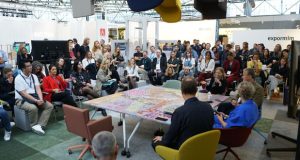Sarah Taylor, Managing Director of BRITA UK, shares advice on how to optimise today’s busy office space for the newest generation in the workforce
Picture the average office a quarter of a century ago and compare it with one today. Far fewer computers would be the obvious difference, but the changes are more far-reaching. The office environment has changed dramatically over the past 25 years, driven largely by the digital revolution and the welcome simplification it has brought in terms of the office layout.
What would have been taking up the space in an office? Many fax machines, quite likely, and piles of paperwork. Today many of these things are now disappearing from the workplace, along with the humble stapler. Other things that have made quiet exits include the unwieldy post trolley and large filing cabinets taking up swathes of floor space.
Like many industries, FM has evolved alongside the changing workspace. Usually one step ahead of the curve, the industry is by its very nature adept at managing change. So, what can the industry expect from the next quarter century? How will the office evolve again? And what will be the driving force behind that evolution?
 SUSTAINABILITY – A FORCE FOR CHANGE
SUSTAINABILITY – A FORCE FOR CHANGE
I believe the work space of the future will be built around the core principals of sustainability, focused on meeting the needs of the present without compromising the ability of future generations to meet their needs. The office of tomorrow is a sustainable workplace designed and built to sustain a workforce.
To find out more about this workforce of tomorrow, BRITA commissioned a piece of research to look more in depth at the views of 1,000 Generation Z and Millennials specifically around sustainability and corporate social responsibility (CSR) in the workplace.
The findings reveal this age bracket is a force for change – they are driven to be the change they hope to see in the world. Their sustainability beliefs are strong, as is their belief in hard work, which means businesses who are able to meet high demands in terms of their place of work, will likely benefit from loyal and driven employees.
WHAT DOES CHANGE LOOK LIKE?
What do Generation Z and Millennials expect from employers when it comes to their workplace? A survey of 1,000 Millennials (those born from the early 80s to mid-90s) and Generation Z (born between the mid-90s and mid-00s) around sustainability and corporate social responsibility (CSR) in the workplace shows its sustainable buildings and sustainable working practices.
This younger generation value highly the sustainability credentials of their employer, with an overwhelming majority (86 per cent) saying they would stay at a company longer if it reported back on how it is lowering its impact on the environment. In terms of priorities, the top three CSR objectives that matter to the younger generation are an environmentally-friendly building (46 per cent) and support for health and wellbeing, crucially including mental health (45 per cent).
PRIORITISING HUMANS AND THEIR NATURAL ENVIRONMENT
Millennials and Generation Z believe in facilitating change. This is a generation that has already witnessed how nations came together and banned CFC gases in the 90s, which directly resulted in the recovery of the ozone layer today. This too is a generation that has grown up with and seen first-hand the impact of climate change and pollution and is deeply concerned about the future.
 Our research shows that the majority of Generation Z and Millennials would feel proud to work at a company that prioritises sustainability and environmental credentials. This isn’t just about eco-friendly initiatives, but also human friendly. BRITA found that the most popular initiative is being flexible in terms of working hours and location, with 50 per cent citing this as their top priority. Openness and transparency also ranked highly (46 per cent), as well as investment in personal development (44 per cent).
Our research shows that the majority of Generation Z and Millennials would feel proud to work at a company that prioritises sustainability and environmental credentials. This isn’t just about eco-friendly initiatives, but also human friendly. BRITA found that the most popular initiative is being flexible in terms of working hours and location, with 50 per cent citing this as their top priority. Openness and transparency also ranked highly (46 per cent), as well as investment in personal development (44 per cent).
What facilities contribute to creating a positive, staff-friendly workspace? Simple measures count for a lot, our research revealed, with a few quick and easy changes creating lasting impact. Quiet zones (52 per cent), hydration stations (31 per cent) and comfy seating areas (31 per cent) are considered the most important design elements for today’s workplace.
Overall, however, being in an environmentally-friendly building is cited as the single most important element for the younger generation when it comes to considering where to work or what job to apply for. The ideal is arriving at work and stepping into a building that has been designed to meet high standards in terms of a low impact on the environment and a high impact on employees’ wellbeing.
HEALTH AND NUTRITION FACILITIES AT WORK
Our research also showed a health and nutrition station is the most popular step employers can take to create a sustainable work environment. This is simple to achieve, by offering fresh fruit plus a BRITA VIVREAU ViTap to provide filtered cold, still and sparkling water on demand, as well as hot water for coffees and teas.
In today’s workplace, sustainability is more important than ever. And for those who fall under the Generation Z and Millennial label, it could be the single aspect of their working lives that matters most. What we now know is that it is important for organisations to focus on their CSR and sustainability credentials if they are to retain the talent of the future
The facilities provided in a workplace, whatever the industry, contribute enormously to the health and wellbeing of the workforce. It is important to recognise that a healthy workforce is also a productive one, which in turn leads to the productivity and success of businesses and the UK economy as a whole. When sustainability is the focus, the future is bright.
To read more about sustainability in the workplace and the younger generation, including expert advice and useful tips, read the full toolkit ‘Life is Better Filtered: Corporate School of Expertise’ at www.fmj.co.uk/brita-white-paper-2/
What are the top five elements the younger generation would like to see in the workplace?
- A health and nutrition station with free health food and unlimited still and sparkling filtered water (54 per cent)
- A single-use plastic-free environment (44 per cent)
- Areas for rest (33 per cent)
- Areas in the workplace that facilitate different types of work (32 per cent)
- In-house gym (31 per cent)




